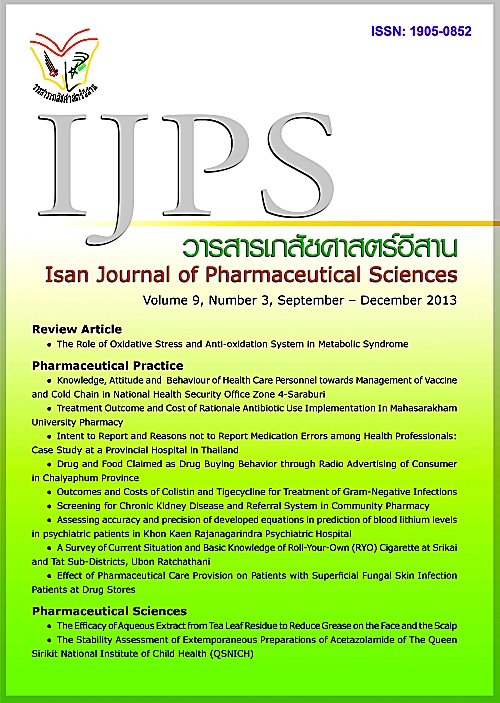The Efficacy of Aqueous Extract from Tea Leaf Residue to Reduce Grease on the Face and the Scalp
Main Article Content
Abstract
The objective of this research was to study the efficacy of the aqueous extract from tea leaf residue to reduce oiliness on the face and the scalp. This research study was conducted to compare the differences in the experimental group between before and after using the extract. The study subjects were eight volunteers of both sexes, aged 18-33 years old who had oily face, small pimples, and acnes. The volunteers had never received any medical treatment for the oily face or facial pimple prior to the beginning of the study. The volunteers were asked to continually use the aqueous extract from tea leaf residue to wipe their faces and rinse their scalps after cleaning their faces and scalps for a period of eight weeks. Analysis was conducted by 1) measuring the oil quantity of the foreheads and scalps of the volunteers prior to starting the experiment on day zero and then on the 28th and 56th days with “Sebumeter”, 2) checking the reduction of pimples from photos, and 3) conducting satisfactory assessment of the volunteers after using the tea extract with “Visual Analog Scale”. The results showed that the oiliness of the volunteers’ faces and scalps was gradually reduced on the 28th and 56th days after application of the aqueous extract from tea leaf residue. There was a statistically significant difference (p<0.05) when the results were compared from the start to the 56th day of the experiment. In addition, the amount of pimples was reduced after visual inspection of the photos. The results showed that most of the volunteers assessed that the aqueous extract from tea leaf residue reduced the oiliness on the face and the scalp, but the volunteers were not satisfied with the smell and color of the extract. The volunteers also suggested that more research was necessary to develop more practical and proper product designs. In summary, the aqueous extract from tea leaf residue can reduce oiliness on the face and the scalp with statistical significant difference after a period of 56-day continuous use.
Article Details
In the case that some parts are used by others The author must Confirm that obtaining permission to use some of the original authors. And must attach evidence That the permission has been included
References
Akiyama H, Fujii K, Yamasaki O, et al. Antibacterialaction of several tannins against Staphylococcus aureus. J Antimicrob Chemother 2001; 48(4): 487–491.
Ding Z, Kuhr S, Engelhardt UH. Infl uence of catechins and theafl avins on the astringent taste of black tea brews. Z Lebensm-Unters-Forsch 1992; 195(2): 108-111.
Kolodziej H, Kiderlen AF. Antileishmanial activity and immune modulatory effects of tannins and related compounds on Leishmania parasitized RAW 264.7 cells. Phytochemistry 2005; 66: 2056–2071.
Lakenbrink C, Lapczynski S, Maiwald B, et al. Flavonoids and other polyphenols in consumer brews of tea and other caffeinated beverages. J Agric Food Chem 2000; 48, 2848–2852.
Lesschaeve I and Noble AC. Polyphenols: factors infl uencing their sensory properties and their effects on food and beverage preferences. Am J Clin Nutr 2005; 81(1), 330S-335
S.Lü L, Liu SW, Jiang SB, et al. Tannin inhibits HIV-1 entry by targeting gp41. Acta Pharmacol Sin2004; 25(2): 213-218.
Peterson J, Dwyera J, Bhagwatb S, et al. Majorfl avonoids in dry tea. J Food Compos Anal 2005; 18: 487–501.
Pothitirat W, Chomnawang MT, Supabphol R, Gritsanapan W. Comparison of bioactive compounds content, free radical scavenging and anti-acne inducing bacteria activities of extracts from the mangosteen fruit rind at two stages of maturity. Fitoterapia 2009; 80(7), 442-227.
Reynolds JEF. Martindale: the extra pharmacopoeia. London: The Pharmaceutical Press; 1989.U.S. Department of Agriculture, USDA Database for the Flavonoid Content of Selected Foods, Release 3. 2011 Sep. [cited on 15 April 2513]. Available from: http://www.ars.usda.gov/SP2UserFiles/Place/12354500/Data/Flav/Flav_R03.pdf


